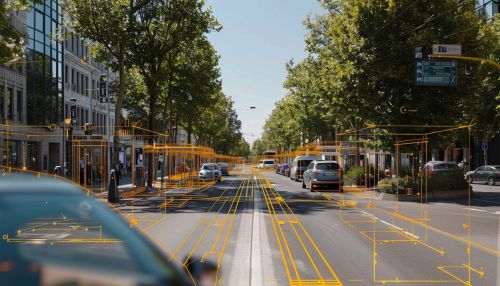Markov Network
Introduction
A Markov Network, also known as a Markov Random Field (MRF), is a model used in probability theory and statistics to represent the dependencies among a set of random variables. It is a type of undirected graphical model that captures the conditional independence properties of the variables. Markov Networks are widely used in various fields, including computer vision, natural language processing, and statistical physics.
Definition and Mathematical Formulation
A Markov Network is defined by an undirected graph \( G = (V, E) \), where \( V \) is a set of nodes representing random variables, and \( E \) is a set of edges representing the dependencies between these variables. Each node \( v \in V \) corresponds to a random variable \( X_v \), and each edge \( (u, v) \in E \) indicates that the variables \( X_u \) and \( X_v \) are conditionally dependent given the other variables in the network.
The joint probability distribution of the random variables in a Markov Network can be factorized according to the cliques of the graph. A clique is a subset of nodes such that every pair of nodes in the subset is connected by an edge. The joint distribution is given by:
\[ P(X) = \frac{1}{Z} \prod_{C \in \mathcal{C}} \phi_C(X_C) \]
where \( \mathcal{C} \) is the set of all cliques in the graph, \( \phi_C \) is a potential function defined on the clique \( C \), and \( Z \) is the partition function, which normalizes the distribution:
\[ Z = \sum_{X} \prod_{C \in \mathcal{C}} \phi_C(X_C) \]
Properties of Markov Networks
Markov Networks have several important properties that make them useful for modeling complex systems:
Conditional Independence
One of the key properties of Markov Networks is the concept of conditional independence. In a Markov Network, two sets of nodes \( A \) and \( B \) are conditionally independent given a third set \( C \) if and only if every path from a node in \( A \) to a node in \( B \) passes through a node in \( C \). This property allows for efficient inference and learning in the network.
Hammersley-Clifford Theorem
The Hammersley-Clifford theorem states that a positive probability distribution that satisfies the Markov property with respect to an undirected graph can be factorized into a product of potential functions over the cliques of the graph. This theorem provides a theoretical foundation for the factorization of the joint distribution in Markov Networks.
Local Markov Property
The local Markov property states that a node in a Markov Network is conditionally independent of all other nodes given its neighbors. This property simplifies the computation of conditional probabilities and is used in various inference algorithms.
Inference in Markov Networks
Inference in Markov Networks involves computing the marginal and conditional probabilities of the random variables. Several algorithms have been developed for this purpose:
Exact Inference
Exact inference algorithms compute the exact probabilities by exploiting the structure of the network. Some common exact inference algorithms include:
- Variable Elimination: This algorithm eliminates variables one by one by summing out their probabilities, resulting in a reduced network.
- Belief Propagation: Also known as the sum-product algorithm, belief propagation iteratively updates the beliefs (marginal probabilities) of the nodes based on the messages received from their neighbors.
Approximate Inference
For large and complex networks, exact inference may be computationally infeasible. Approximate inference algorithms provide an alternative by approximating the probabilities. Some common approximate inference algorithms include:
- Monte Carlo Methods: These methods use random sampling to estimate the probabilities. Examples include Gibbs Sampling and Metropolis-Hastings Algorithm.
- Variational Methods: These methods approximate the true distribution by a simpler distribution and optimize the parameters to minimize the difference. Examples include Mean Field Approximation and Expectation Propagation.
Learning in Markov Networks
Learning in Markov Networks involves estimating the parameters of the potential functions from data. This can be challenging due to the high dimensionality and dependencies among the variables. There are two main approaches to learning in Markov Networks:
Parameter Learning
Parameter learning aims to estimate the parameters of the potential functions given the structure of the network. Some common techniques for parameter learning include:
- Maximum Likelihood Estimation: This method maximizes the likelihood of the observed data given the parameters.
- Bayesian Estimation: This method incorporates prior knowledge about the parameters and updates the estimates based on the observed data.
Structure Learning
Structure learning aims to discover the structure of the network (i.e., the edges) from the data. This is a more challenging task as it involves searching over the space of possible graphs. Some common techniques for structure learning include:
- Score-Based Methods: These methods assign a score to each possible graph and search for the graph with the highest score. Examples include the Bayesian Information Criterion (BIC) and the Minimum Description Length (MDL) principle.
- Constraint-Based Methods: These methods use statistical tests to determine the conditional independence relationships among the variables and construct the graph accordingly.
Applications of Markov Networks
Markov Networks have been successfully applied in various fields due to their ability to model complex dependencies among variables. Some notable applications include:
Computer Vision
In computer vision, Markov Networks are used for tasks such as image segmentation, object recognition, and stereo vision. They provide a flexible framework for modeling the spatial dependencies among pixels and regions in an image.


Natural Language Processing
In natural language processing (NLP), Markov Networks are used for tasks such as part-of-speech tagging, named entity recognition, and machine translation. They capture the dependencies among words and phrases in a sentence, allowing for more accurate predictions.
Statistical Physics
In statistical physics, Markov Networks are used to model the interactions among particles in a system. They provide a probabilistic framework for studying the behavior of complex systems, such as Ising models and Potts models.
